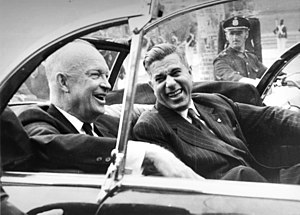
Benito Nardone Cetrulo (November 22, 1906 – March 25, 1964) was a Uruguayan journalist and political figure.
Biography
Nardone was born at Montevideo, the son of an Italian immigrant.
For many years he was a popular radio commentator at CX 4 Radio Rural. His political prominence came about after his long established reputation as a radio personality.
He was strongly identified with rural affairs. Prior to assuming the Presidency, he was seen as politically close to Domingo Bordaberry and his son Juan María Bordaberry, both of them heavily involved with a Ruralist affairs organization led by Nardone.
He was a prominent member of the Uruguayan National (Blanco) Party.
President of the National Council of Government
In 1960 Nardone's Blanco Party colleague Martín Echegoyen stepped down as President of the National Council of Government, so Nardone succeeded Echegoyen as president, remaining in charge until 1961.
Nardone was himself succeeded as President by Eduardo Víctor Haedo, also a Blanco Party colleague.
See also
References
- 'Benito Nardone', Misplaced Pages (in Spanish), es:Benito Nardone
- 'Liga Federal de Acción Ruralista' (in Spanish), Misplaced Pages, es:Liga Federal de Acción Ruralista
External links
![]() Media related to Benito Nardone at Wikimedia Commons
Media related to Benito Nardone at Wikimedia Commons
| Political offices | ||
|---|---|---|
| Preceded byMartín Echegoyen | President of the Uruguayan National Council of Government 1960 – 1961 |
Succeeded byEduardo Víctor Haedo |
This article about a Uruguayan politician is a stub. You can help Misplaced Pages by expanding it. |
This article about a Uruguayan journalist is a stub. You can help Misplaced Pages by expanding it. |
- 1906 births
- 1964 deaths
- People from Montevideo
- Uruguayan people of Italian descent
- National Party (Uruguay) politicians
- Presidents of the National Council of Government (Uruguay)
- Uruguayan radio journalists
- Uruguayan radio presenters
- Burials at the Central Cemetery of Montevideo
- Liga Nacional de Accion Ruralista politicians
- Uruguayan politician stubs
- South American journalist stubs
- Uruguayan writer stubs
